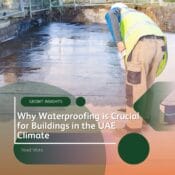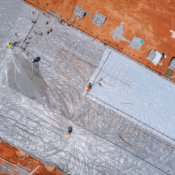
Common Waterproofing Mistakes to Avoid in Dubai Construction Projects
Waterproofing is a critical aspect of construction, particularly in regions like Dubai, where the climate poses unique challenges. With high temperatures, humidity, and occasional heavy rainfall, effective waterproofing is essential to protect buildings from water damage. However, many contractors and homeowners make common mistakes that can lead to significant issues down the line. This blog will identify these pitfalls and provide insights on how to avoid them, ensuring a robust waterproofing system that stands the test of time.
1. Inadequate Surface Preparation Before Application
One of the most frequent mistakes in waterproofing projects is inadequate surface preparation. Proper preparation is crucial for ensuring that waterproofing materials adhere correctly and perform as intended.
- Cleaning the Surface: Before applying any waterproofing material, surfaces must be thoroughly cleaned to remove dust, debris, grease, and any loose particles. Failure to do so can lead to poor adhesion, resulting in delamination of the waterproofing layer.
- Repairing Defects: Any cracks or defects in the substrate should be repaired before application. Unaddressed imperfections can compromise the integrity of the waterproofing system, allowing water to seep through.
- Priming: In many cases, applying a primer is essential to enhance adhesion between the substrate and the waterproofing membrane. Skipping this step can lead to peeling or flaking of the waterproofing layer over time.
In Dubai's harsh environment, where UV exposure and temperature fluctuations are prevalent, thorough surface preparation cannot be overstated. Neglecting this step can lead to costly repairs and extensive damage later on
2. Choosing the Wrong Type of Waterproofing Method for Specific Areas
Another significant mistake made during construction projects is selecting inappropriate waterproofing methods for specific applications. Different areas of a building require tailored solutions based on their unique exposure to moisture.
- Understanding Different Methods: Common waterproofing techniques include cementitious waterproofing, liquid-applied membranes, bituminous coatings, and injection waterproofing. Each method has its own advantages and ideal applications. For instance:
- Cementitious Waterproofing: Best suited for internal wet areas like bathrooms and kitchens due to its ease of application and strong bonding properties.
- Liquid Applied Membranes: Ideal for roofs and balconies as they provide a seamless barrier that can accommodate structural movements.
- Bituminous Coatings: Highly durable and effective for below-grade applications such as basements.
Choosing the wrong method can lead to premature failure of the waterproofing system. For example, using a cementitious coating on a roof may not withstand UV exposure effectively, leading to degradation over time.
3. Neglecting Maintenance After Installation
Waterproofing is not a one-time solution; it requires ongoing maintenance to ensure its effectiveness over time. Many property owners overlook this aspect, leading to significant issues later.
- Regular Inspections: Conduct periodic inspections of the impervious areas to identify any signs of damage or wear. Look for cracks, punctures, or signs of water infiltration.
- Timely Repairs: Address any issues immediately using compatible materials as per manufacturer guidelines. Even minor cracks can allow water seepage if left unaddressed.
- Cleaning and Resealing: Regularly clean joints and penetrations and reseal them as necessary. Accumulated debris can trap moisture against surfaces, increasing the risk of damage.
- Drainage Systems: Ensure that drainage systems are functioning correctly to prevent water accumulation on surfaces that have been waterproofed. Stagnant water can degrade membranes over time.
4. Failing to Consider Structural Movement
Buildings are dynamic structures that undergo various movements due to temperature changes, settling, or seismic activity. Failing to account for this movement during the design and installation of waterproofing systems can lead to failures.
- Incorporating Expansion Joints: Use expansion joints strategically in areas prone to movement. These joints allow for controlled movement without compromising the integrity of the waterproofing system.
- Flexible Membranes: Consider using flexible membranes that can accommodate some degree of movement without cracking or separating. This flexibility is crucial in preventing leaks caused by structural shifts.
5. Ignoring Manufacturer Instructions
Each waterproofing product comes with specific application guidelines provided by the manufacturer. Ignoring these instructions can lead to improper application and subsequent failures.
- Application Techniques: Follow recommended techniques for mixing, applying, and curing materials. For instance, improper curing times can affect adhesion and performance.
- Environmental Conditions: Be aware of environmental conditions during application—extreme heat or humidity can impact how materials cure and bond.
6. Overlooking Details at Penetrations and Terminations
Penetrations (such as pipes) and terminations (where membranes meet other surfaces) are often weak points in a waterproofing system if not properly addressed.
- Sealing Penetrations: Ensure that all penetrations are adequately sealed with compatible materials that adhere well to both the pipe and surrounding substrate.
- Detail Work: Pay close attention to termination points where membranes meet walls or other surfaces. Proper detailing here is vital for creating a continuous watertight barrier.
7. Misunderstanding Tile Grout Properties
A common misconception among homeowners is that tile grout is inherently waterproof. While some grouts have water-resistant properties, they are not completely impermeable.
- Using Appropriate Grouts: When tiling wet areas like bathrooms or kitchens, use specialized grout products designed for water resistance (e.g., epoxy grouts).
- Regular Maintenance: Maintain grout lines by periodically resealing them to enhance their resistance against moisture infiltration
Waterproofing is an essential component of building construction in Dubai's challenging climate. By avoiding common mistakes—such as inadequate surface preparation, incorrect method selection, neglecting maintenance, failing to consider structural movement, ignoring manufacturer instructions, overlooking details at penetrations, and misunderstanding tile grout properties—contractors and homeowners can significantly improve their waterproofing systems' effectiveness.
Investing time in proper planning and execution will not only protect buildings from water damage but also save money on costly repairs down the line. As construction practices evolve with new technologies and materials emerging in the market, staying informed about best practices in waterproofing will ensure long-lasting protection against moisture-related issues in Dubai's unique environment



